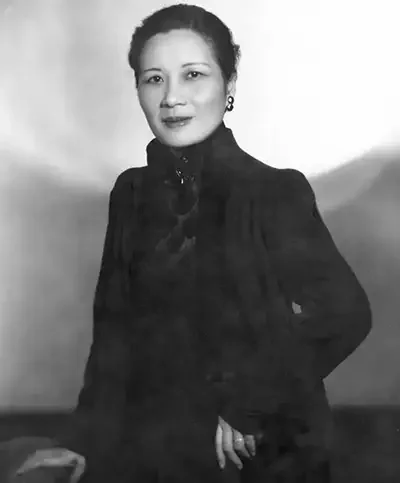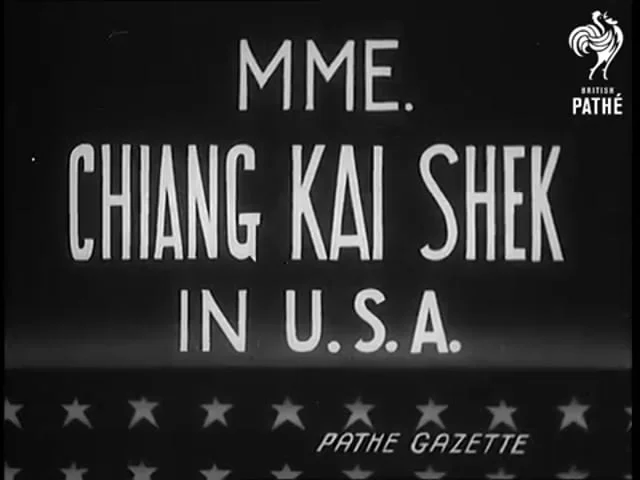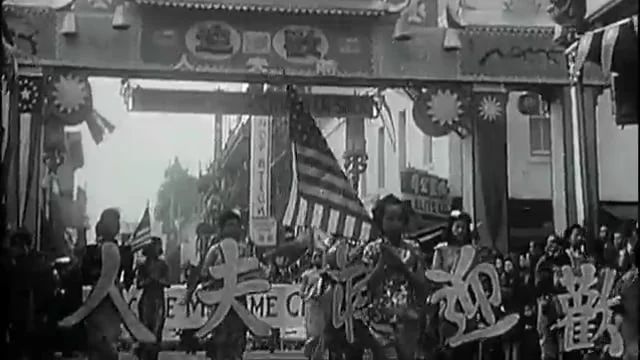- Military History
- Biographies
- Politicians Biographies
- Madame Chiang Kai-shek - Soong Mei-ling
Madame Chiang Kai-shek - Soong Mei-ling
Wife of Nationalist leader Chiang Kai-shek and fundraiser for the Chinese war efforts
Soong Mei-ling was the first and the most famous woman of her day to break through the barriers of traditionally male-dominated Chinese society. By using extraordinary intelligence and eloquence to charm the members of the United States Congress into giving financial support and armaments to her country, she was an important part of the reason influential Americans supported China during World War II.
She became known internationally as Madame Chiang Kai-shek but was a force in her own right. Although she never held an official position during her extraordinarily long life (one that spanned three centuries) she played an important diplomatic role for China during World War II and afterward, challenging the traditional role of women in Chinese society.
Chiang Mei-ling, born Soong Mei-ling (often spelled May-ling), did not follow the traditional path of a female born in China in the late nineteenth century. Educated in the United States, she found it difficult to assimilate back into Chinese society as a youthful woman. After marrying Chinese leader Chiang Kai-shek, she helped advance the agenda of the National Party (Kuomintang or short "KMT") by advising on foreign affairs, pursuing diplomatic relations, and making use of the press. She was the first and most famous woman of that time to challenge the stereotypical role of females in Chinese society.
Formative Years of Soong Mei-ling (Madame Chiang Kai-shek)
The children of an aristocratic mother, Ni Kwei-tseng, and a peasant father, Han Chiao-shun (Charlie Soong) who would become a tycoon, Soong Mei-ling and her five siblings were educated in the United States (Soong Mei-ling will be referred to by her given name, Mei-ling, throughout this biography to distinguish her from the other members of her large and famous family). The eldest, Ai-ling, attended the first women’s college, Wesleyan, in Macon, Georgia. The Shanghai gentry were shocked that her father had chosen to, in their view, waste money educating a daughter.
Ching-ling, the second sister, followed Ai-ling to Wesleyan. Later she ran off to marry Sun Yat-sen, the leader of the Chinese revolution and her father’s closest friend, who was already married with three children. Devout Methodists, the Soong parents tried but failed to get the marriage annulled.
Sun Yat-sen, who managed with a group of reformers to capitalize on the fall of the Qing dynasty (which had been in power since 1644) in 1911, was elected provisional president of China that same year. He ceded the position to Yuan Shikai, a military man who dissolved parliament and then tried but failed to have himself crowned emperor. After Yuan’s death in 1916, China entered the warlord era, during which provincial generals could defy a weak government while battling over power and territory.
Mei-ling, the Soongs’ fourth child and third daughter, followed Ching-ling to Georgia when she was only ten years old. A smart, willful child, her pre-college education included public and private schooling and private tutoring. When Ching-ling graduated from Wesleyan, Mei-ling transferred to Wellesley College in Massachusetts to be near her older brother who was at Harvard, since their parents would not allow her to remain alone in Georgia.
Considered “rather plain”, Mei-ling was short and chubby. Like her schoolmates, she kept a confession book: “My one extravagance [is] clothes, she wrote… my secret sorrow, being fat”. Though her southern American accent was sometimes interpreted as suggesting that she was not well-educated, Mei-ling was highly intelligent, graduating in 1917 with honors. Independent and somewhat remote, Mei-ling made one close friend at Wellesley - Emma Mills, a would-be writer from New York - and they remained friends throughout their lives.
Upon arriving back in China, Mei-ling was put in charge of the large family residence in Shanghai, a job that included supervising its twelve servants. She also took over much of the responsibility for her two younger brothers. “They are hard to manage because they are deucedly clever and lazy at the same time”, she wrote Emma. While Mei-ling was disciplining her young brothers, their mother, dismayed at her youngest daughter’s figure, put her on a strict diet. Mei-ling dropped to 45kg (100 pounds) - a weight she proudly maintained into old age.
Mei-ling’s return home coincided with a financial boom at the end of World War I. Although she took part in the social whirl that accompanied the money fever of Shanghai’s upper crust, she also looked for work to keep her busy and interested. An atypical member of the moneyed class, she enjoyed shocking society with her Western attire - dresses with waistlines, jodhpurs, and tennis clothes. She started teaching a Sunday school class composed entirely of boys (one of her students called her “Sir”) and later joined the Film Censorship Committee of China.
Still, she was not content. “I wish I were doing something real: something towards a career”, she wrote Emma. Having observed the dirty, ragged swarming humanity in Shanghai’s slums, Mei-ling jumped at the chance when the Shanghai Municipal Council asked her to join the Child Labor Commission, on which no one from China, male or female, had ever served. The investigation of working conditions in Shanghai’s factories was a revelation. Contractors searched the countryside for areas of flood or drought, bought entire villages of women and children, housed them in dwellings, required them to work fourteen hours every day except Chinese New Year, and demanded payment for their room and board before they could leave. The worst were the silk factories where the women’s hands were purplish-red and often blistered by having to work with hot vapor issuing forth from the open containers. In the early twentieth century, young Chinese women, even from the best families, were considered inferior to men, and good only for procreating and playing games like mahjong.
China in Chaos
While Mei-ling was searching for something to do with her life, Chiang Kai-shek was struggling to rise in the military profession. Born in a mountain village, given a typical Chinese education based on rote and memorization, and married at fourteen (in an arranged marriage) to a village girl, he left for Japan to prepare himself for a military career. There, he became involved in the Chinese revolutionary movement. Upon returning to Shanghai, he enjoyed the dissipations readily available in the city, disappearing from military headquarters for months at a time and contracting venereal disease, a condition that apparently led to sterility.
In 1921 they appointed him military counselor to Sun Yat-sen. Unable to control either his own party or the local warlords, Sun, who had always dreamed about leading an expedition to northern China, fled Guangzhou with a minor air force and all the soldiers he could gather. By the time he reached Beijing and was diagnosed with liver cancer, he was in significant pain. At his bedside when he died on the 12th March 1925 were his two children and his wife Ching-ling, along with her sisters Mei-ling and Ai-ling. The struggle to take Sun’s place broke out immediately after his death, and Chiang, who initially was at the bottom of the list of hopefuls, rose quickly to the top. Named commander of the newly titled Northern Punitive Expedition plus head of the Central Executive Committee of the Kuomintang and its Military Council, he was now titular head of both the party and the army.
Setting out to overcome the warlords in control of China, Chiang’s army moved northward with incredible speed; by September 1926 it had reached the Yangtze (Chang) River, 800 kilometers north of Guangzhou, and had tripled in size. To monitor the radical members of the Nationalist Party, Chiang asked the party to move headquarters to the city of Wuhan. After seeing the chaos that ensued in the city, he decided that Borodin must be forced to leave China.
Chiang was not the only person appalled by the Wuhan contingent. Mei-ling, who had made two trips to Sun’s death, spent three months in Wuhan visiting Ching-ling who had traveled north with Borodin. Although she held lengthy conversations with Borodin, she was fully aware of the cynicism that lay behind his arguments. Chiang declared war on the radicals, who reacted immediately, wiring that the party had taken away all Chiang’s power and that he should await orders. But while the Communists sent Chiang letters urging him to confess his mistakes, Shanghai stopped accepting Wuhan’s currency, Chiang’s soldiers captured the center of the opium trade (the major source of Wuhan’s income), and the soldiers sent by Wuhan to capture Beijing were defeated. Two months later the Chinese Communists were officially thrown out of the Nationalist Party. Borodin fled to Russia, Ching-ling returned home to Shanghai, and Chiang announced his retirement, leaving both his government and army leaderless and frantic.
Meeting Chiang Kai-shek
There are conflicting stories about how Mei-ling and Chiang met and married, but they became attracted to each other during the visits Mei-ling made to Guangzhou and Wuhan in the winter of 1926–1927. He first mentions missing her in his diary in March 1927. Shortly after that Ai-ling took charge, meeting him on a boat anchored near Shanghai. During their lengthy conversation she proposed that Chiang marry Mei-ling and that both her brother and her husband Kung be given important positions in his government.
Before announcing his retirement, Chiang had paid an unannounced visit to his wife Jennie at her mother’s home, during which he had pleaded nervously for her to take two friends and accept tickets he had bought for a boat sailing for the United States. He explained that he wanted her to go abroad for five years and swore they would resume their marriage at the end of that period. Although Jennie left China as Madame Chiang Kai-shek, by the time her ship arrived in San Francisco, Chiang had issued a statement saying that “the woman who arrived from China was not his wife”, adding that “he does not know the Madame Chiang Kai-shek mentioned in the dispatches”.
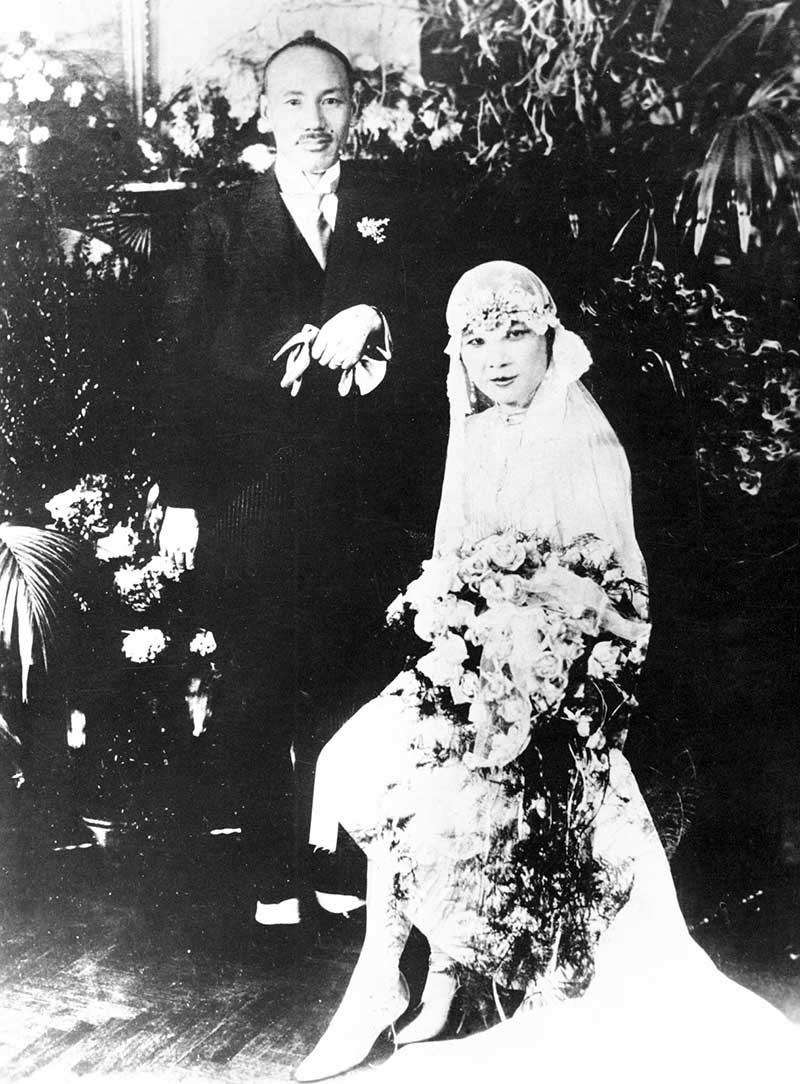
Meanwhile, Chiang had emerged from his brief retirement, Mei-ling had accepted his proposal of marriage, and he had sailed for Japan to get her mother’s permission. An enthusiastic Methodist, Madame Soong asked him to convert to Christianity; when he said he would read the Bible and decide she agreed to the marriage. Chiang and Mei-ling were married on the 1st of December 1927. Their wedding aroused a good deal of speculation as to the motives of the participants: was it love, attraction, the melding of power and family status, or all of the above?
Recognition of Chiang’s Government
Six weeks later Chiang resumed the leadership of the Nationalist Party and the army. Although Mei-ling complained (as usual) of being ill, she hurried to their new capital of Nanjing. While her husband was preparing to continue the Northern Expedition and her brother was raising the funds in Shanghai, Mei-ling was adapting to a life different from any she had ever known. She was the rare wife of an official who followed her husband into a primitive city with no comfortable accommodations, heat, or sewage, moving into army headquarters in Nanjing and seeming to revel in the discomforts of her choice. Assuming the role of the leader’s wife, she opened a canteen where army officers could relax, learn to draw, and produce propaganda posters for the Nationalist cause.
After her recent husband left with his army, Mei-ling took charge of the home front. When he wired asking her to send medicine, hospital gowns, and as many excellent doctors as she could find. By early July 1928 Chiang had overcome the warlords in his path and made a triumphal entry into Beijing. He then hurried back to Nanjing to escort Mei-ling to Beijing, where she joined him in a ceremonial pilgrimage to Sun Yat-sen’s grave.
During that summer Great Britain recognized Chiang’s government and sent its ambassador to Nanjing. Diplomats from eleven other countries followed suit, tacitly recognizing the right of Chiang’s government to run the country and collect taxes. With the diplomatic community based in Nanjing, Mei-ling’s role became essential. Chiang spoke no English, and she did all the translating, acting both as his official interpreter and chief advisor on foreign affairs.
Chiang’s military victories, however, had not solved his problems with either the Communists or the warlords. The latter continued to challenge the Nationalist Party, moving in and out of alliances that fought to take over the country and collect the taxes. Meanwhile, the Chinese Communists launched a series of rebellions with an integrated army of soldiers and peasants; the Communist Party leadership, including Mao Zedong, encouraged them to round up and kill local landlords. By 1930 they had moved to the southeastern province of Kiangsu, and for the next four years Chiang sent nearly a million soldiers into the area to destroy them. The last of five major campaigns finally succeeded, routing the Communists out of their refuge and sending them off on the Long March, a 9,600-kilometer (6,000-mile) journey from Jianxi Province in the southeast to Shaanxi Province in the northwest; they eventually settled in Shaanxi Province, where they founded a Communist revolutionary base in Yan’an.
Throughout her husband’s battles, Mei-ling continued to provide help, and she, like her sister Ching-ling, had found a man to love and serve. In the summer of 1930 Mei-ling accompanied Chiang to the front, giving her an opportunity to convert him to the Methodist faith of her family by bringing missionaries into their home and giving him lessons in Christianity. In October he agreed to be baptized, an unpopular conversion interpreted by many as a ploy to get American support in what looked like China’s inevitable clash with Japan.
Second Sino-Japanese War
By the early 1930s Japan, in search of men and raw materials, was preparing to invade China, which it did in September 1931, attacking and overrunning Manchuria. Four months later, China was forced to sign a treaty establishing a line sixteen kilometers (nine miles) north of Beiping (Beijing), beyond which they allowed no Chinese troops. Two years later the “Young Marshal”, Zhang Xueliang, whom Chiang had named as deputy commander-in-chief of the National Revolutionary Army, and a passionate admirer of Mei-ling, turned against Chiang when the latter, determined to eliminate the Chinese Communists before dealing with foreign enemies, ordered him to attack a group of Chinese students instead of fighting the Japanese.
Then, while Chiang was staying at a resort near Xi’an, he was kidnapped by soldiers of the Young Marshal in union with a local warlord named Yang Hucheng. After several others had tried and failed, Mei-ling flew to Xi’an and convinced the kidnappers to send her husband back to Nanjing. The long-term result of the affair was disastrous, as the Japanese, expecting future cooperation between the Nationalists and the Communists, waited only six months before attacking and taking over the city of Shanghai, moving north, razing the countryside, and arriving at the capital of Nanjing, where they committed the horror that came to be known as the Rape of Nanjing.
As the Japanese cut a bloody path through China, Mei-ling assumed the voice of the victim, crying out for help to the rest of the world. Her partner in this was William Henry Donald, a former Australian journalist who created a press campaign around her. After the Chiangs, who left Nanjing just before the Japanese arrived, settled in their wartime capital of Chongqing, Mei-ling served as Chiang’s chief troubleshooter. Starting work early every morning and often continuing until midnight.
World War II and American Aid
In 1939 the Second Sino-Japanese War had reached an impasse. One million Japanese soldiers were holding the most strategic positions in China (the ports and big cities) while Chiang, having withdrawn to Chongqing, did very little either to fight the enemy or to help mistreated Chinese citizens in Japanese occupied territory. The following spring the Japanese began a series of air raids, and Mei-ling did her part to raise global awareness by describing the horrors in ringing tones for the outside world.
By the middle of the following year, most of northern Europe was in Nazi hands, and Chinese morale had fallen to an all-time low. US President Franklin D. Rooseveltworried that if Chongqing fell, China was lost, but he believed that if China remained an active adversary, Japan would continue to be distracted from her broader ambitions. The solution to the problem was to find supplies that the Chinese could use to fight the Japanese. When Britain refused 100 out-of-date planes, China took them, along with 100 American pilots who received $750 a month from the Chinese government plus $500 for every Japanese plane shot down. The following year, Congress approved President Roosevelt’s Lend-Lease Act, which allowed the United States to lease, sell, transfer, or exchange defense equipment with its allies.
One month later the Soviets signed a neutrality pact with Japan, leaving the Japanese free to do anything they wanted in China since they no longer had anything to fear from the Russians. The Chiangs, who had done everything possible to push Russia into war against Japan, were dismayed. Mei-ling was particularly disappointed, as she had taken an active part in troublemaking, supplying misinformation to the Soviets, and telling them that the greatest support the Soviet Union could render China would be to declare war on Japan. Eight months after they signed the pact, however, the Japanese attacked Pearl Harbor. Chinese leaders now thought their country was bound to be of vital importance to the American war effort and that all the money and equipment China needed would roll in from the west.
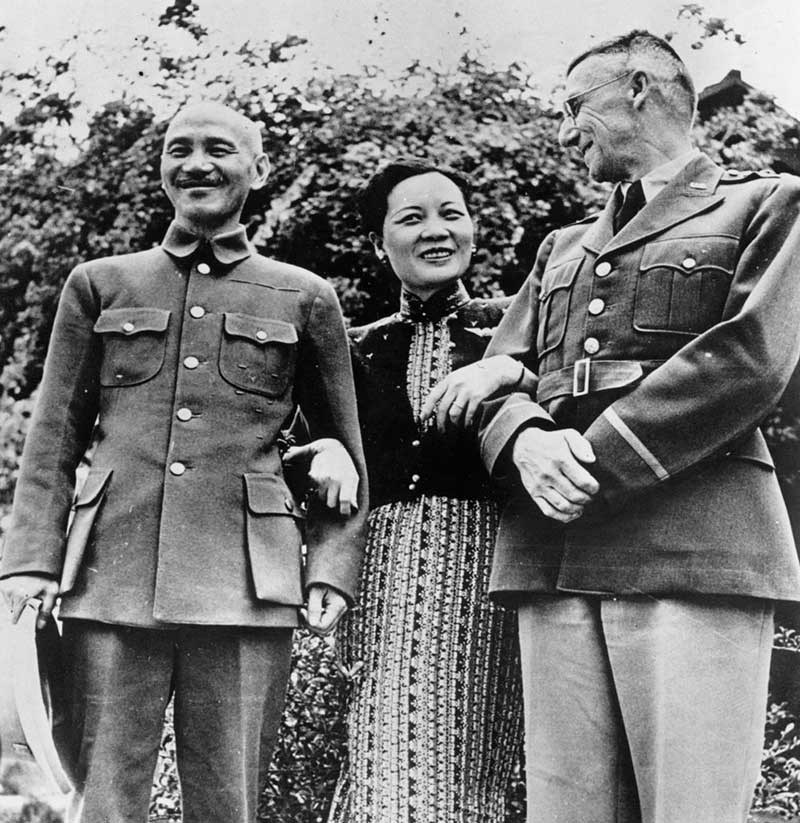
Shortly thereafter, the US government sent Joseph Stilwell to China. His duties included distribution of weapons and supplies under the Lend-Lease Act, command of the US armies, and command of many of Chiang’s soldiers. They expected Stilwell to work with Chiang who, in contrast, based his every move on saving face - not what he did but how it appeared to the world.
In the autumn of 1942 Roosevelt sent Wendell Willkie, his recent opponent for the presidency, on a foreign tour. Chiang regarded Willkie’s visit as an opportunity to get more funds and armaments from the United States and to impress the man who might one day become the American president. It is said that Mei-ling and Willkie had an affair during his visit. With an invitation from First Lady Eleanor Roosevelt to visit the United States lying on her desk, Mei-ling allegedly followed Willkie back to the US under the pretense of consulting with American doctors about her ever-failing health.
Her American break started in a New York hospital, where she was diagnosed with nervous disorders. From there she proceeded to Washington, DC, where she wowed both houses of Congress with her looks, her speaking prowess, and her ability to raise vast amounts of money without ever seeming to ask for it. Unfortunately, Mei-ling’s public persona was coupled with an imperious nature, which turned the White House staff against her and worried the president. Roosevelt was afraid that Mei-ling’s dismissive behavior with reporters would damage his pro-China policy, already jeopardized by her fabulous jewels and furs that sat poorly on a woman begging for supplies for starving citizens of her country. He tried to get her to leave the United States early, but she embarked on a lengthy tour that took her to Hollywood and lasted eight months.
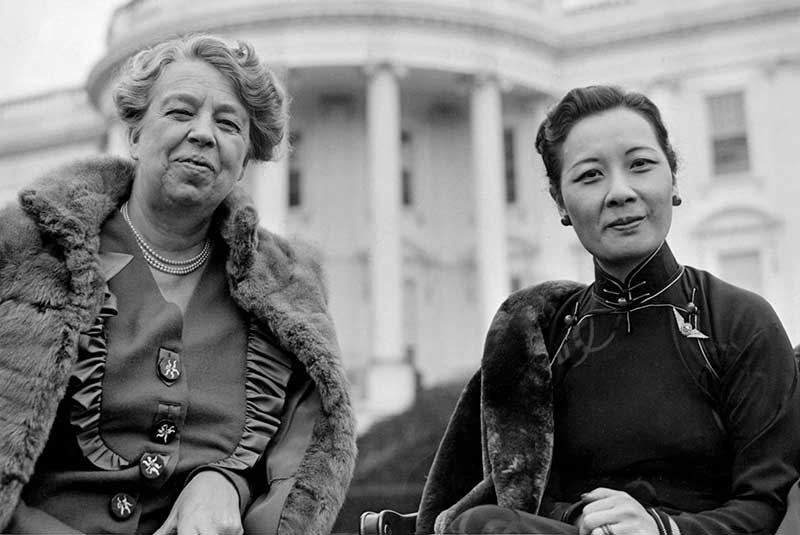
Six months after her return from the United States, Mei-ling accompanied her husband on a trip to Cairo for a summit with Roosevelt and British prime minister Winston Churchill. The only woman at the conference, she allowed no one else to translate for Chiang or to interpret his remarks for others.
The elevation of China to a position of equal status with the United States, the United Kingdom, and Russia, did not, as they have expected might, improve morale at home. Two attempts to remove Chiang from office while he was in Egypt failed, but a third was more serious. When General Stilwell, who had accompanied the Chiangs to Cairo, returned, he told his chief of staff he had been directed to prepare a plan for the assassination of Chiang Kai-shek.
They devised a scheme involving an airplane and two malfunctioning para-shoots with the help of two trustworthy American officers, but the order to carry it out never came. Unwilling to take any action beyond hoarding arms to fight the Communists, Chiang and his army were unprepared to withstand a new Japanese offensive in April 1944. But while Chiang (or the Generalissimo, as he was called) merely observed the situation from Chongqing, Stilwell was leading thirty thousand American-trained Chinese soldiers through swampy jungles to the front, where he was on the verge of opening the Burma Road into China, which would be China’s only link to the outside world. All he needed were reinforcements to complete the mission, but Chiang refused to send more soldiers and even threatened to withdraw those already there. Stilwell cabled Washington, which cabled Chiang telling him (in no uncertain terms) that he must supplement Stilwell’s troops. Furious, humiliated, Chiang demanded that Stilwell be removed. In October 1944, the American general left China and was replaced by General Albert Wedemeyer.
When the Generalissimo’s wife finally returned to China from America, she had to deal with stories that Chiang had been having an affair with another woman, whom he had brought into their household. Suffering from gossip and skin disease, Mei-ling left China for Brazil with her sister Ai-ling in the summer of 1944, and from there moved on to New York, where she stayed until the end of World War II. She arrived back in China two weeks after the armistice.
Political Decline
At the end of 1945, US General George Marshall arrived in China to help Chiang resist the Chinese Communist Party (CCP) and establish the United States as an impartial mediator between the two factions fighting over the country. Sent on an impossible mission, Marshall left a year later, having established a warm friendship with Mei-ling. Shortly thereafter, US President Harry S. Truman(who succeeded Roosevelt upon his death in 1945) sent Wedemeyer back to China to investigate the situation. Wedemeyer found evidence of bad administration, corruption, and lethargy in Chiang’s government. These sentiments were echoed by Marshall, now Secretary of State, who counseled against sending any more equipment to Chiang unless the United States was prepared to take over his government.
By the beginning of January 1948, it was apparent that Chiang’s government, with ten million Chinese on the verge of starvation, was falling apart politically, militarily, and financially. That summer the Generalissimo who had lost seven armies and over 400,000 men, admitted that his troops could no longer even hold the capital of Shenyang (known as Mukden). When Chiang failed to get more supplies from the United States, Mei-ling, thinking she could accomplish what he could not, left for America.
Her trip (described by a 1948 Washington Post article as a frantic, hopeless mission to woo back the Chinese supply line) was a failure. To counter recent terrible publicity, Mei-ling had brought only one fur coat and a minimal amount of luggage. But President Truman, who accused her family of stealing $750,000 of the money the United States had given to China, refused to give her anymore. She started her stay with a visit to the Marshalls’ Virginia farm, then set to work to see what she could do to counter rumors that her husband was about to make peace with the CCP. But Chiang, who had already moved 500,000 ounces of gold (approximately 14,000 kilograms), 300,000 of his soldiers, 26 gunboats, and his entire air force to Taiwan, temporarily resigned in January 1949, leaving his vice president to negotiate with the Communists. Nine months later, on 1 October 1949, Mao Zedong proclaimed the establishment of the People’s Republic of China, and the Generalissimo fled to Taiwan. In January 1950 he was followed by Mei-ling, who explained that, although she had been urged to stay in the United States, God (“an ethereal Voice”) had spoken to her and told her to return to share the fate of my husband and my people.
As soon as Mei-ling arrived on the island, she tackled the problem of the current rift between the Nationalists and the US government, assuring the Americans that the Nationalist government was not asking for American troops, but only advice on technical matters. She then toured the military hospitals, where she discovered that soldiers wounded in battle were not being paid. Within a few weeks she had visited Chiang’s troops on the island of Quemoy, bearing cigarettes, food, and Bibles. A 1950 New York Times article noted that more frequent and effective Nationalist air raids on coastal cities didn’t coincide accidentally with Mei-ling’s return home. She founded a Women’s League, which pressed local businesses into building houses for military families and started a prayer group. For relaxation, she took up painting and brought in two masters to teach her. Told that she had the makings of a talented artist, she believed it and repeated it to her friends.
The Korean War in 1950 brought American General Douglas MacArthur to Taiwan, where Chiang asked his opinion about various requests that his wife lead a guerrilla group on the mainland. MacArthur replied that the danger was too great and if caught, they would subject her to torture and death, so the subject was dropped. It is hard to determine why Chiang told MacArthur this, unless he was trying to signal desperation to the Americans. Whatever the reason, after MacArthur’s dismissal by Truman, Dean Rusk (Secretary of State from 1961 to 1969) said that Chiang’s philosophy more accurately represented the views of the Chinese people than Mao Zedong, and the United States sent large sums in military aid and economic support to the area, much of which was designated for Taiwan.
Two years later Mei-ling again made what she hoped would be a triumphal return to the American spotlight, speaking out against the Communists and writing articles to back up her speeches. As if to underscore her complaints, the mainlanders tossed fifty thousand shells in two hours at the island of Quemoy, an attack that continued for five days. Although Secretary of State John Foster Dulles had once suggested that the Nationalist government leave the island, he and Chiang issued a joint statement saying that the Nationalist government was the authentic spokesman for free China. This was not enough for Mei-ling, who appeared on “Meet The Press” saying that a Taiwanese invasion of the mainland was growing nearer and nearer. This statement was a precursor to a full-fledged campaign started by Chiang in Taiwan, informing the mainlanders that the time for collective action is here and guaranteeing the readiness of the Nationalist Army to back up the Taiwanese.
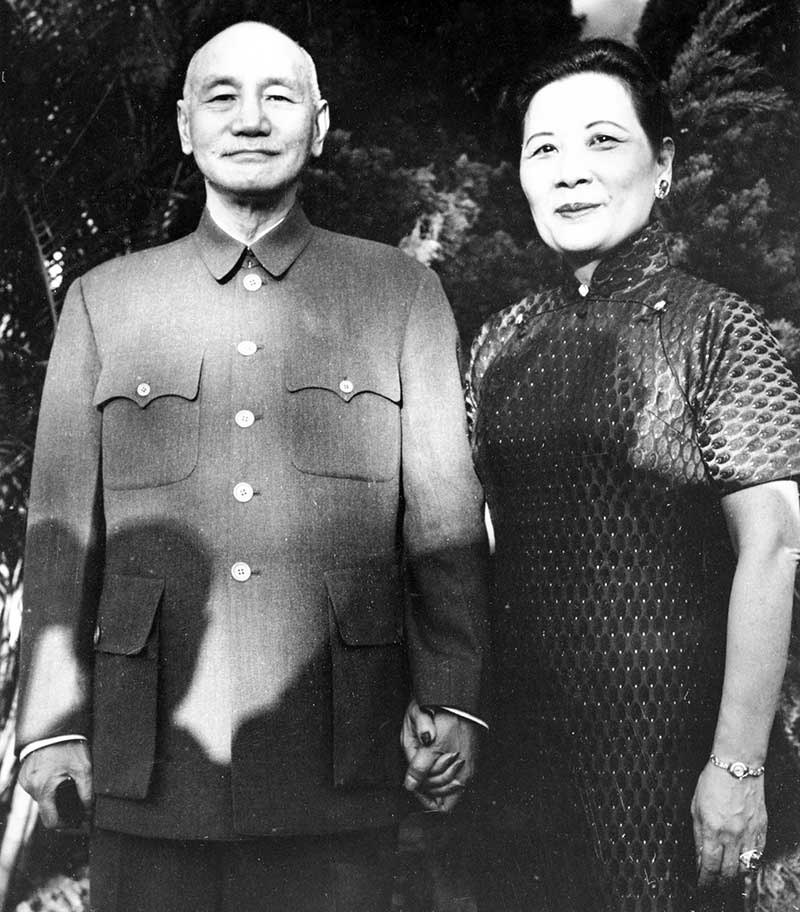
The Chiangs also continued to strengthen their efforts to maintain their government-in-exile as the legitimate representative of China at the United Nations, using Taiwan’s technical superiority to help African nations with agricultural output in exchange for their votes in the world body. But in January 1964, when French President Charles de Gaulleannounced France’s recognition of the Communist mainland as the representative of China at the UN, Chiang broke off diplomatic relations with France and sent Mei-ling back to America once again.
Mei-ling left Taiwan in the summer of 1965 and stayed in the United States for over a year, during which time she gave eighteen major speeches, stressing the fact that the CCP’s possession of the atomic bomb jeopardizes the position of every nation in the world. During this visit she made several enemies, people who claimed she must be trying to get the United States government to support nationalist troop landings on the Chinese mainland as part of a general escalation of the war in South Vietnam. In October 1966 Arkansas Senator J. William Fulbright asked the State Department to nourish the hope of returning to the mainland to sustain morale on the island of Taiwan, the key men of my generation realize that it may be a long time before a non-Communist regime can be reestablished in Mainland China. Chiang Kai-shek was convinced that a combination of the Cultural Revolution and the escalation of the Vietnamese War would give him opportunities to attack the mainland. It fell to his wife, however, to make one last-ditch effort to get American support for a Nationalist invasion of the mainland - a plea that was strongly discouraged, first by Virginia Senator Harry Byrd on a visit to Taiwan and then by Richard M. Nixon, who visited Taipei the year before he became president. Nixon, however, was so impressed with Mei-ling’s intelligence, persuasiveness, and moral force that he said she could have become an important leader in her own right.
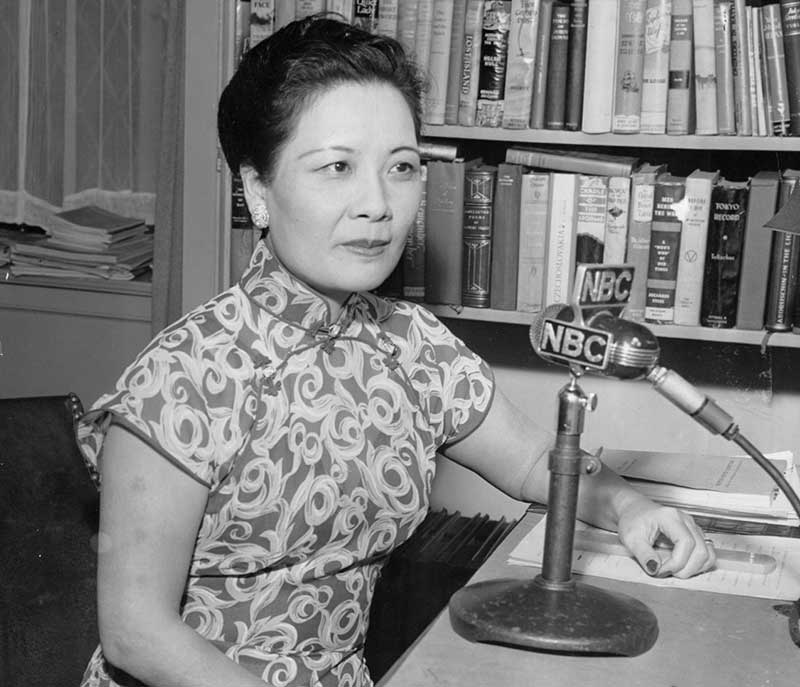
During the summer of 1967, Mei-ling and her husband were riding in their limousine to their mountain home when a jeep swerved over the dividing line of the highway, causing their front escort car to halt and their limo to plow into it. Almost a year later, Mei-ling claimed that she could not write, paint, or stand for any amount of time on her left leg because of a jolt to her head which had injured her spinal cord, causing pain in her right arm and hand and her left leg. She also spent time in the hospital, complaining of whiplash and other spinal injuries.
When Nixon took office in January 1969, the Chiangs knew that the new president did not accept the continued isolation of Communist China, and in July 1971 Nixon sent Chiang a message via a mutual acquaintance: “Whatever the future may hold, I’ll never forget my old friend”. Days later, after the president’s announcement of National Security advisor Henry Kissinger’s secret trip to Beijing and the ensuing fury in Taiwan, the United States proposed dual representation for China in the United Nations, which Chiang refused. In October 1971 Nixon sent another spokesman, Ronald Reagan (governor of California at the time) to Taipei to inform the Generalissimo of Nixon’s impending trip to Beijing. Chiang, however, would not be appeased, and in his inaugural address in 1972 complained of being confined on his island. One step backward, he said, would leave us no place for burial,
Later Years and Legacy
Less than two months later, Chiang, who had been showing serious signs of aging since the limo accident, suffered a cardiac arrest. During his last illness, Mei-ling assumed his role, along with her own, of outraged spokesperson against the Communists. Chiang died in April 1975, and five months later his widow left for the United States with more than a dozen aides and nurses. From then on, she made her home in New York.
She lived part time in an apartment in New York City (a duplex for which she kept twenty-four full-time servants) and part-time in the Kung family home in the Long Island, New York, town of Locust Valley. She returned to Taiwan only twice - once to say goodbye to her favorite niece who was dying of cancer and once to halt reforms that Chiang’s son, Chiang Ching-kuo, now premier, was effecting. In 1995 at ninety-eight she was a guest of honor at a senate reception in Washington, DC, celebrating the fiftieth anniversary of the end of World War II. In 1996 she attended the preview of an exhibit of Chinese art at the Metropolitan Museum in Manhattan, and at the turn of the century visited a showing of her own work in New Jersey. She always enjoyed celebrating her birthday in March, when friends and relatives gathered at her apartment for dinner. Mei-ling’s last party was for her 105th birthday in 2002. Hospitalized with pneumonia on her 106th, she died on 12 October 2003.
Mei-ling became known internationally as the wife of Chiang Kai-shek, but she was a force in her own right. Though she never held an official position, she played an important diplomatic role for China during World War II and afterward, challenging the traditional role of women in Chinese society.
Madame Chiang Kai-shek - Soong Mei-ling - Quick Facts
- Chinese Revolution or Xinhai Revolution (1911 - 1912)
- Northern Expedition - China (1926 - 1928)
- Chinese Civil War (1927-36 & 1946-50)
- Japanese Invasion of Manchuria (1931-32)
- Kumul Rebellion (1931-1934)
- Soviet invasion of Xinjiang (1934)
- Second Sino-Japanese War (1937-1945)
- WWII (1939-1945)
- Cold War (1947-1991)
- Kuomintang Islamic insurgency (1950-1958)
- {{#owner}}
- {{#url}} {{#avatarSrc}}
{{name}} {{/url}} {{^url}} {{#avatar}} {{& avatar}} {{/avatar}} {{name}} {{/url}} - {{/owner}} {{#created}}
- {{created}} {{/created}}


